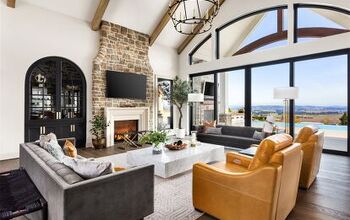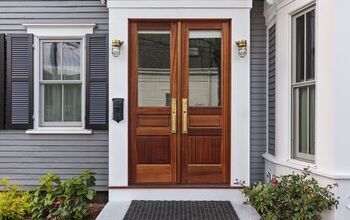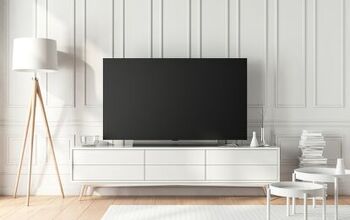How To Design Shared Spaces When You Have Opposite Styles

You love your partner, but their style? Not so much. So what happens when you’re designing your home? Do you draw straws? Arm wrestle? Those probably aren’t the best ideas. Therefore, you need to compromise and design your shared spaces in a way that embraces both of your styles.
Discuss how you want your home to feel and function. Choose a neutral base and allow each person to have a signature design moment in each room. Bridge the gap between conflicting styles with a cohesive color palette. Be strategic when choosing how to split design decisions, and let each person design their own personal spaces.
If you feel like you’re fighting a constant battle between who has the best style, it’s time for a new approach. It’s not that one person’s design sensibilities are better than the other's. Instead, it’s about finding a balance.
The True Challenge When Designing For Two
Even if one person agrees to let the other design everything exactly how they want, it’s not going to work out in the long run. One of you is going to end up living somewhere that doesn’t feel like home.
Now, here’s the good news. When you and your partner have opposite styles, it can lead to some of the most visually interesting and deeply personal spaces. Therefore, instead of asking who wins the battle, ask how can we both feel at home here.
When you share a home with someone whose style doesn’t reflect your own, the real design challenge isn’t just about aesthetics. It’s about respect, creativity, compromise, and partnership. Here’s how to build a space you both love.
1. Start With Feelings
When couples, or even roommates, begin decorating, they often jump straight into picking out furniture, decor, rugs, and paint. This might seem productive, but if your styles aren’t in sync, you could be wasting time and money.
Before choosing anything, it’s important to ask how you want the space to feel. Together, see if you can find any similarities in the overall vibe you’re going for in the space, even if your aesthetic preferences may differ.
Forget about how much you adore mid-century modern, or think boho-chic is the best option. How do you want your home to feel? Do you dream of a serene, peaceful retreat or an upbeat, hip hangout? Do you want something that feels luxurious or casual?
Together, discuss words that would describe your ideal space and what activities you want to happen in each area. Keep notes and look for any similarities between your answers that could help you find a good balance.
This step reveals your deeper values when it comes to your home. Once you identify them, your design decisions can support a shared vision for how your home should feel and function.
2. Embrace Unexpected Overlap
As you’re discussing how you each want to feel in your space, create lists of likes and dislikes. Compare your lists, and you’ll likely find a few places where you share the same sentiments.
For example, you both realize you detest gold for fixtures and hardware, love a monochromatic color palette, and want lots of hidden storage. When you’re dealing with two different styles, embracing any shared preferences is an excellent way to introduce compromise and cohesiveness into the design.
Next, look for ways you can combine certain wants. For example, if you love the idea of modern, black fixtures, and your partner loves vintage, look for an industrial, vintage light fixture.
3. Agree On A Neutral Foundation
When working with two distinct styles, it’s best to start with a neutral base. A neutral canvas makes it easier to layer in decor and accessories that reflect each person’s style, while still achieving an intentional, cohesive look.
Therefore, stick with neutrals for your non-negotiable base layers, like the floor, walls, and big-ticket furniture items (sofa, dining table, bed). You can then dress these basics up with more niche design choices in the form of rugs, pillows, art, and other items.
When you clash on certain decisions, go with the more subtle option for larger, pricier pieces. Express your individual personalities through more affordable or smaller elements that are easier to change when the mood strikes.
4. Each Person Gets To Have A Signature Style Moment
Agree to let each person have one signature moment in each room. For example, you get your modern light fixture in the dining room, but your partner gets to have the more rustic dining bench.
Assuming you listened to the previous tip and started with a neutral base, these different styles should live in harmony. Plus, each person gets to feel a connection to the space instead of as if they’re a stranger in their own home.
Repeat this step in every room of the house. In the bedroom, maybe you get to choose the bedding, but your partner chooses the art. You select a vibrant rug for the living room, and your spouse gets their set of simple, leather chairs.
There’s nothing wrong with introducing some contrast into a space. But do it intentionally to keep the overall look balanced.
5. Don’t Focus On A 50/50 Split
Compromising when it comes to designing your space isn’t about each of you getting to design half of the room. Most likely, taking this route would end up landing you in a hodge-podge of colors, finishes, and decor.
Instead, focus on what matters most to each person when splitting the decisions. For example, if you’re all about comfort, then perhaps you get to choose the pillows for the sofa or the sofa style. If your partner is a big art fan, perhaps they get to choose the primary art pieces for the space.
It’s important to let each person have a voice, share their opinions, and express what they value. It might help to rate how important things are to you on a scale of 1 to 10. If lighting is a 5 for you but a 10 for your partner, let them choose the fixture.
If you both place equal importance on the same elements, then you can divvy it up by room. So, if you both feel lighting is super important, maybe you get to choose the fixtures for the bedrooms and bathrooms. Consequently, your partner chooses the kitchen and dining room lighting, etc.
6. Create Cohesiveness With Color
Color has a powerful ability to unify differences. If one person loves dramatic contrast and the other prefers soothing neutrals, a shared palette can bridge the gap.
Follow these steps to create a cohesive color palette that anchors your design.
- Choose three main colors and two supporting tones.
- Carry these colors throughout your design by incorporating them into furniture, art, fabrics, decor, and more.
- The style doesn’t have to match; the color will create the connection for you.
- You don’t have to use the same shade or tone. For example, you might use a bright yellow on some throw pillows and a more muted yellow on a vase across the room.
7. Mix Materials Intentionally
Opposites attract, and mixing materials gets a big green light in the design world, but you need to do it intentionally. Consider your materials as the mediators of your design. Here are a few popular combinations:
- Metal and wood
- Velvet and linen
- Smooth surfaces and rough finishes
- Leather and burlap
- Dark and light
- Square edges and rounded corners
When mixing materials or elements, repeat each one at least twice in the room, so it feels intentional and not as if it’s an afterthought.
8. Bring Balance To The Space Using Visual Weight
Just because you have two different styles in a space, that doesn’t mean things need to feel like they clash. Remember, the key to bridging the gap between two styles is to find balance. But how do you balance two different looks?
You need to balance the visual weight. Balance dark, chunky furniture with light fabrics. Even out ornate, detailed patterns with simple, sleek lines. If you have a busy, oversized, vibrant art piece on the wall, go minimal with surface decor in the room.
Step back and look at the room; you can feel (and see) if something feels off. Everything possesses visual weight, so it’s important to pair heavier pieces with airier ones.
9. Personal Space Stays Personal
Finally, you don’t have to share every single thing in your home. You may have a home office that your partner never uses, and they might have a special reading nook.
Each person should get to design these spaces with their own personal touches and items. Reserve mutual agreement for the shared spaces in your home.
Your Shared Home Should Reflect Your Relationship
There’s nothing wrong or surprising about two people living together with opposite styles. In fact, it’s probably rarer to find someone who likes every single thing you do. But a home is a place where everyone who lives there feels like they belong.
Therefore, turn your house into a visual demonstration of you and your partner’s shared creativity and problem-solving skills. Mixing two styles under one roof has great potential to build a beautiful, personal, and unique space.
It can also bring you and your partner closer together, with both parties feeling comfortable and at peace. After all, isn’t that what home is really all about? In the end, it shouldn’t look like one person lives there, but instead, look like a place where two people are building a life together.
Related Guides:
- Why It’s Worth Mixing Vintage And Modern Styles In Home Design
- Design Your Home For How You Want To Feel, Not Just How It Looks
- Five Key Characteristics Of Bohemian (Boho) Design

Stacy Randall is a wife, mother, and freelance writer from NOLA that has always had a love for DIY projects, home organization, and making spaces beautiful. Together with her husband, she has been spending the last several years lovingly renovating her grandparent's former home, making it their own and learning a lot about life along the way.
More by Stacy Randall










![The 5 Best Angle Grinders – [2022 Reviews & Buyer's Guide]](https://cdn-fastly.upgradedhome.com/media/2023/07/31/9071326/the-5-best-angle-grinders-2022-reviews-buyer-s-guide.jpg?size=350x220)


![Finishing Basement Without Permit [Is It Really Illegal?]](https://cdn-fastly.upgradedhome.com/media/2023/07/31/9070078/finishing-basement-without-permit-is-it-really-illegal.jpg?size=350x220)













